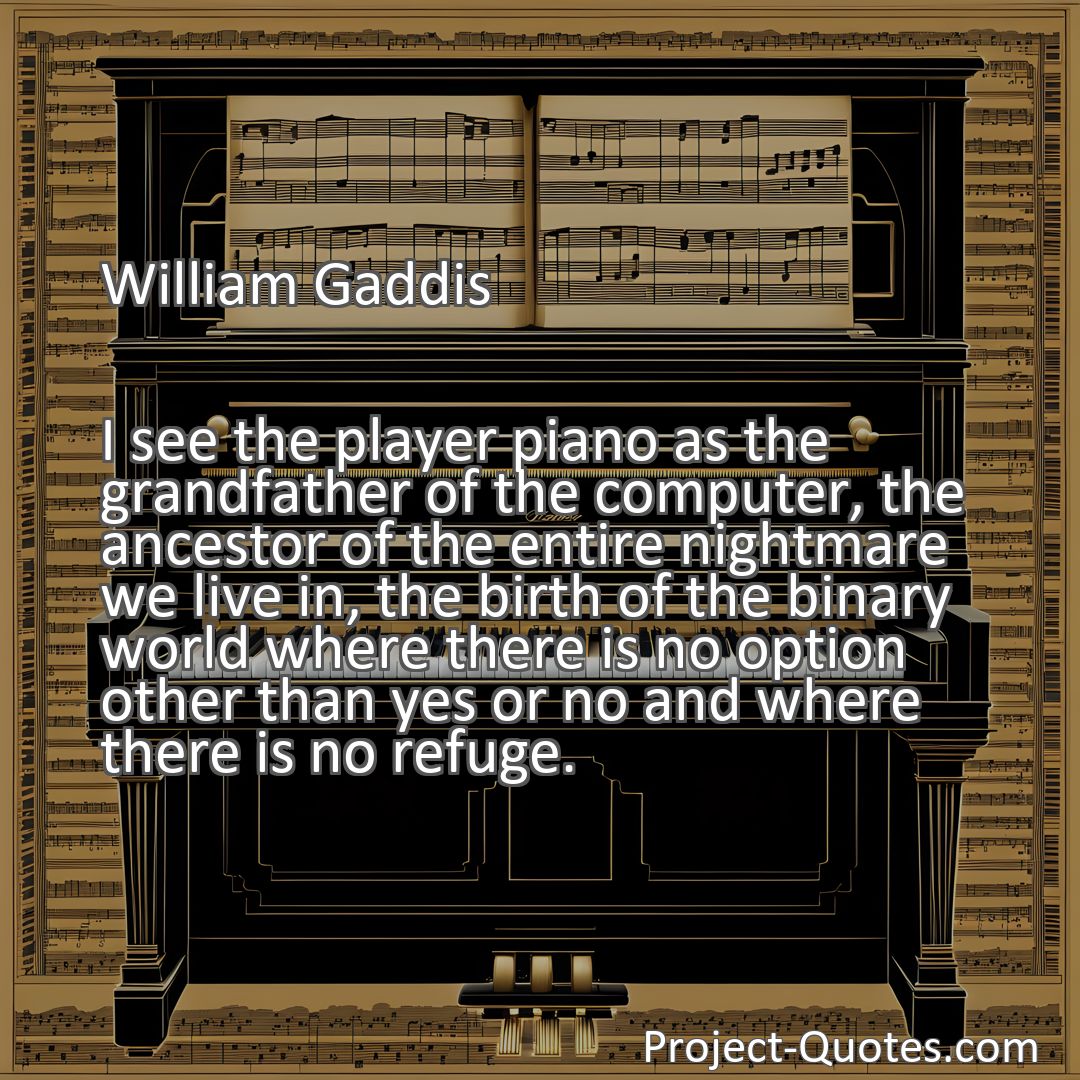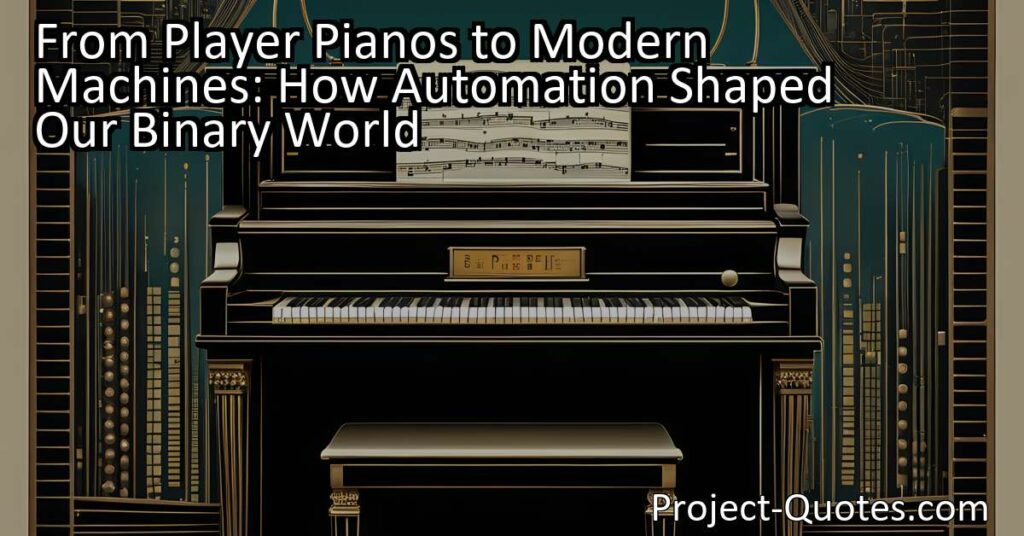I see the player piano as the grandfather of the computer, the ancestor of the entire nightmare we live in, the birth of the binary world where there is no option other than yes or no and where there is no refuge.
William Gaddis
From Player Pianos to Modern Machines: How Automation Shaped Our Binary World Discover how the humble player piano, an invention often overlooked, paved the way for the advanced machines we rely on today. As author William Gaddis suggests, the player piano’s significance as the “grandfather of the computer” shows how automation has transformed our world and made it possible for machines to handle complex tasks. Dive into the history and inner workings of this mechanical marvel to understand the parallel between the binary mechanism of the player piano and the binary code that powers our digital age.
Table of Contents
- 1 I see the player piano as the grandfather of the computer, the ancestor of the entire nightmare we live in, the birth of the binary world where there is no option other than yes or no and where there is no refuge.
- 2 William Gaddis
- 3 Meaning of Quote – I see the player piano as the grandfather of the computer, the ancestor of the entire nightmare we live in, the birth of the binary world where there is no option other than yes or no and where there is no refuge.
- 4 Freely Shareable Quote Image
- 5 Related
Meaning of Quote – I see the player piano as the grandfather of the computer, the ancestor of the entire nightmare we live in, the birth of the binary world where there is no option other than yes or no and where there is no refuge.
Have you ever stopped to think about the humble beginnings of the technology that surrounds us today? It’s incredible to consider how innovations from the past have paved the way for the advancements we now take for granted. One such invention that often goes unnoticed in its significance is the player piano – an invention that author William Gaddis refers to as the “grandfather of the computer” and the “ancestor of the entire nightmare we live in.”
At first glance, you may wonder how a simple player piano could be connected to our modern binary world and the loss of refuge. To understand the depth of Gaddis’ statement, we need to delve into the history and inner workings of this mechanical marvel.
The player piano, also known as the pianola, emerged in the late 19th century as a means of automatically playing music. It fascinated audiences with its ability to reproduce the performance of a live pianist without any human intervention. By utilizing a system of perforated paper rolls and intricate mechanisms, the player piano brought music to life in homes, saloons, and other establishments across the globe.
In its time, the player piano was a groundbreaking invention, much like the computer is today. It represented a new level of automation and provided a glimpse into the possibilities of a future where machines could handle complex tasks once delegated solely to humans. Gaddis recognizes this parallel and suggests that the player piano’s impact on society serves as a precursor to our current reality.
When Gaddis mentions the birth of the “binary world,” he alludes to the fundamental nature of computers and their reliance on binary code – a system composed of only ones and zeros. Just as the player piano operated through a binary mechanism of perforations on the punched paper rolls, computers rely on binary code to execute commands. This connection highlights the player piano’s role as an early pioneer of the binary world that dominates our lives today.
In contrast to the analog world, where shades of gray and infinite possibilities exist, the binary world is characterized by its stark simplicity. It presents us with a limited set of options: yes or no, on or off, true or false. Gaddis suggests that this binary nature has permeated our lives, leaving little room for nuance or ambiguity. We are forced to make decisions, often hasty, in a world where there seems to be no middle ground.
Furthermore, Gaddis laments the loss of refuge in a binary world. In a player piano’s melodic performance, there is a certain comfort and solace, a space where one can immerse oneself in the beauty of music. However, as the player piano paved the way for more automated devices, we have seen a decline in the human touch that once brought warmth and intimacy to various aspects of our lives.
Consider the experience of listening to a live pianist playing a heartfelt piece with subtle variations in tempo, dynamics, and phrasing, versus listening to a mechanical rendition by a player piano. While the latter may be technically flawless, it lacks the soul and emotional resonance that can only be conveyed by a human performer. Similarly, as our world becomes increasingly mechanized and digital, we risk losing the deeper connections and meaningful experiences that are only possible through human interaction.
Gaddis’ quote challenges us to reflect on the unintended consequences of progress and automation. While the player piano itself may seem harmless and unassuming, its influence on the development of technology sets in motion a chain of events that shapes the fundamental aspects of our lives today. It serves as a reminder that advancements, no matter how innocent they may appear at first, can have far-reaching implications.
As we continue to navigate the complexities of our binary world, it is crucial to remember the value of human connection and the beauty in the gray areas, where multiplicity and diversity thrive. While technology undoubtedly offers numerous benefits and conveniences, we must be cautious not to lose sight of our humanity in the process.
In conclusion, Gaddis’ quote brings our attention to the player piano’s significant role in shaping our modern world. By recognizing its status as the “grandfather of the computer,” Gaddis highlights the player piano’s contributions to the binary world we inhabit today. He also invites us to ponder the consequences of living in such a world, where options are limited, and refuge seems scarce. Ultimately, Gaddis challenges us to consider the importance of embracing the humanity and complexity that exist outside the realm of yes or no, and to strive for balance in an increasingly automated and digitized society.
I hope this quote inspired image brings you hope and peace. Share it with someone who needs it today!


